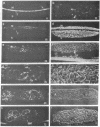Abstract
The glycoprotein laminin is found exclusively in the basement membranes of adult tissues, not in the mesenchymal stroma. We studied the appearance and distribution of laminin during the early formation of kidney tubules in mouse embryos and in an in vitro transfilter model system. In immunofluorescence using affinity-purified antibodies, the distribution of laminin showed a clear correlation, both spatially and temporally, to the early stages of tubule formation. In vivo, laminin was first detected in a punctate pattern in areas where the pretubular aggregates form; later, it became confined to the basement membranes of the tubules. In experiments in vitro, the nephrogenic mesenchyme was found to form tubules after 12-24 hr of transfilter contact with the inductor. The first laminin spots were found after 12 hr of culture, 24 hr before overt morphogenesis. As the mesenchymal cells began to aggregate and elongate (at 36 hr), laminin was detected in those cells destined to become epithelial, and at 48 hr it was not found in cells remaining in the stroma. In more mature tubules (at 72 hr), laminin was seen as a sharp band in the basement membranes. It is suggested that laminin is involved in the increased cell adhesiveness during the early aggregation of the nephrogenic mesenchyme.
Full text
PDF




Images in this article
Selected References
These references are in PubMed. This may not be the complete list of references from this article.
- Bernfield M. R., Banerjee S. D., Cohn R. H. Dependence of salivary epithelial morphology and branching morphogenesis upon acid mucopolysaccharide-protein (proteoglycan) at the epithelial surface. J Cell Biol. 1972 Mar;52(3):674–689. doi: 10.1083/jcb.52.3.674. [DOI] [PMC free article] [PubMed] [Google Scholar]
- Cohn R. H., Banerjee S. D., Bernfield M. R. Basal lamina of embryonic salivary epithelia. Nature of glycosaminoglycan and organization of extracellular materials. J Cell Biol. 1977 May;73(2):464–478. doi: 10.1083/jcb.73.2.464. [DOI] [PMC free article] [PubMed] [Google Scholar]
- David G., Bernfield M. R. Collagen reduces glycosaminoglycan degradation by cultured mammary epithelial cells: possible mechanism for basal lamina formation. Proc Natl Acad Sci U S A. 1979 Feb;76(2):786–790. doi: 10.1073/pnas.76.2.786. [DOI] [PMC free article] [PubMed] [Google Scholar]
- Dawid I. B., Wahli W. Application of recombinant DNA technology to questions of developmental biology: a review. Dev Biol. 1979 Mar;69(1):305–328. doi: 10.1016/0012-1606(79)90294-x. [DOI] [PubMed] [Google Scholar]
- Ekblom P., Nordling S., Saxen L., Rasilo M. L., Renkonen O. Cell interactions leading to kidney tubule determination are tunicamycin sensitive. Cell Differ. 1979 Oct;8(5):347–352. doi: 10.1016/0045-6039(79)90019-8. [DOI] [PubMed] [Google Scholar]
- GROBSTEIN C. Some transmission characteristics of the tubule-inducing influence on mouse metanephrogenic mesenchyme. Exp Cell Res. 1957 Dec;13(3):575–587. doi: 10.1016/0014-4827(57)90087-3. [DOI] [PubMed] [Google Scholar]
- Grobstein C. Mechanisms of organogenetic tissue interaction. Natl Cancer Inst Monogr. 1967 Sep;26:279–299. [PubMed] [Google Scholar]
- Linder E., Vaheri A., Ruoslahti E., Wartiovaara J. Distribution of fibroblast surface antigen in the developing chick embryo. J Exp Med. 1975 Jul 1;142(1):41–49. doi: 10.1084/jem.142.1.41. [DOI] [PMC free article] [PubMed] [Google Scholar]
- Orkin R. W., Gehron P., McGoodwin E. B., Martin G. R., Valentine T., Swarm R. A murine tumor producing a matrix of basement membrane. J Exp Med. 1977 Jan 1;145(1):204–220. doi: 10.1084/jem.145.1.204. [DOI] [PMC free article] [PubMed] [Google Scholar]
- Russell W. C., Newman C., Williamson D. H. A simple cytochemical technique for demonstration of DNA in cells infected with mycoplasmas and viruses. Nature. 1975 Feb 6;253(5491):461–462. doi: 10.1038/253461a0. [DOI] [PubMed] [Google Scholar]
- Saxen L., Wartiovaara J. Cell contact and cell adhesion during tissue organization. Int J Cancer. 1966 May 15;1(3):271–290. doi: 10.1002/ijc.2910010307. [DOI] [PubMed] [Google Scholar]
- Saxén L., Koskimies O., Lahti A., Miettinen H., Rapola J., Wartiovaara J. Differentiation of kidney mesenchyme in an experimental model system. Adv Morphog. 1968;7:251–293. doi: 10.1016/b978-1-4831-9954-2.50011-2. [DOI] [PubMed] [Google Scholar]
- Saxén L., Lehtonen E. Transfilter induction of kidney tubules as a function of the extent and duration of intercellular contacts. J Embryol Exp Morphol. 1978 Oct;47:97–109. [PubMed] [Google Scholar]
- Saxén L., Saksela E. Transmission and spread of embryonic induction. II. Exclusion of an assimilatory transmission mechanism in kidney tubule induction. Exp Cell Res. 1971 Jun;66(2):369–377. doi: 10.1016/0014-4827(71)90690-2. [DOI] [PubMed] [Google Scholar]
- Thesleff I., Lehtonen E., Saxén L. Basement membrane formation in transfilter tooth culture and its relation to odontoblast differentiation. Differentiation. 1978 Mar 13;10(2):71–79. doi: 10.1111/j.1432-0436.1978.tb00948.x. [DOI] [PubMed] [Google Scholar]
- Timpl R., Rohde H., Robey P. G., Rennard S. I., Foidart J. M., Martin G. R. Laminin--a glycoprotein from basement membranes. J Biol Chem. 1979 Oct 10;254(19):9933–9937. [PubMed] [Google Scholar]
- Tkacz J. S., Lampen O. Tunicamycin inhibition of polyisoprenyl N-acetylglucosaminyl pyrophosphate formation in calf-liver microsomes. Biochem Biophys Res Commun. 1975 Jul 8;65(1):248–257. doi: 10.1016/s0006-291x(75)80086-6. [DOI] [PubMed] [Google Scholar]
- Vaheri A., Mosher D. F. High molecular weight, cell surface-associated glycoprotein (fibronectin) lost in malignant transformation. Biochim Biophys Acta. 1978 Sep 18;516(1):1–25. doi: 10.1016/0304-419x(78)90002-1. [DOI] [PubMed] [Google Scholar]
- Vracko R. Basal lamina scaffold-anatomy and significance for maintenance of orderly tissue structure. Am J Pathol. 1974 Nov;77(2):314–346. [PMC free article] [PubMed] [Google Scholar]
- Wartiovaara J., Stenman S., Vaheri A. Changes in expression of fibroblast surface antigen (SFA) during cytodifferentiation and heterokaryon formation. Differentiation. 1976 Jun 4;5(2-3):85–89. doi: 10.1111/j.1432-0436.1976.tb00896.x. [DOI] [PubMed] [Google Scholar]
- von der Mark H., von der Mark K., Gay S. Study of differential collagen synthesis during development of the chick embryo by immunofluorescence. I. Preparation of collagen type I and type II specific antibodies and their application to early stages of the chick embryo. Dev Biol. 1976 Feb;48(2):237–249. doi: 10.1016/0012-1606(76)90088-9. [DOI] [PubMed] [Google Scholar]







